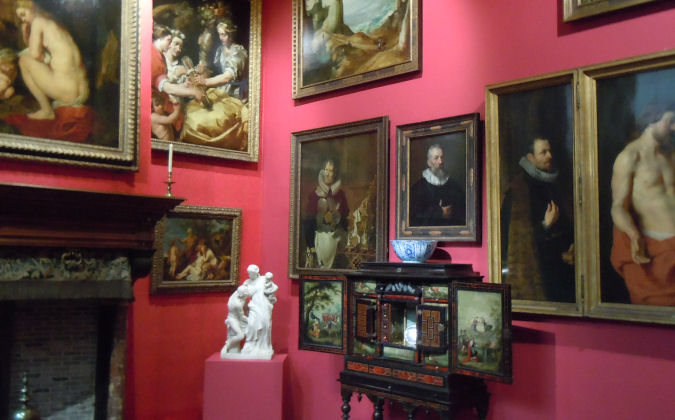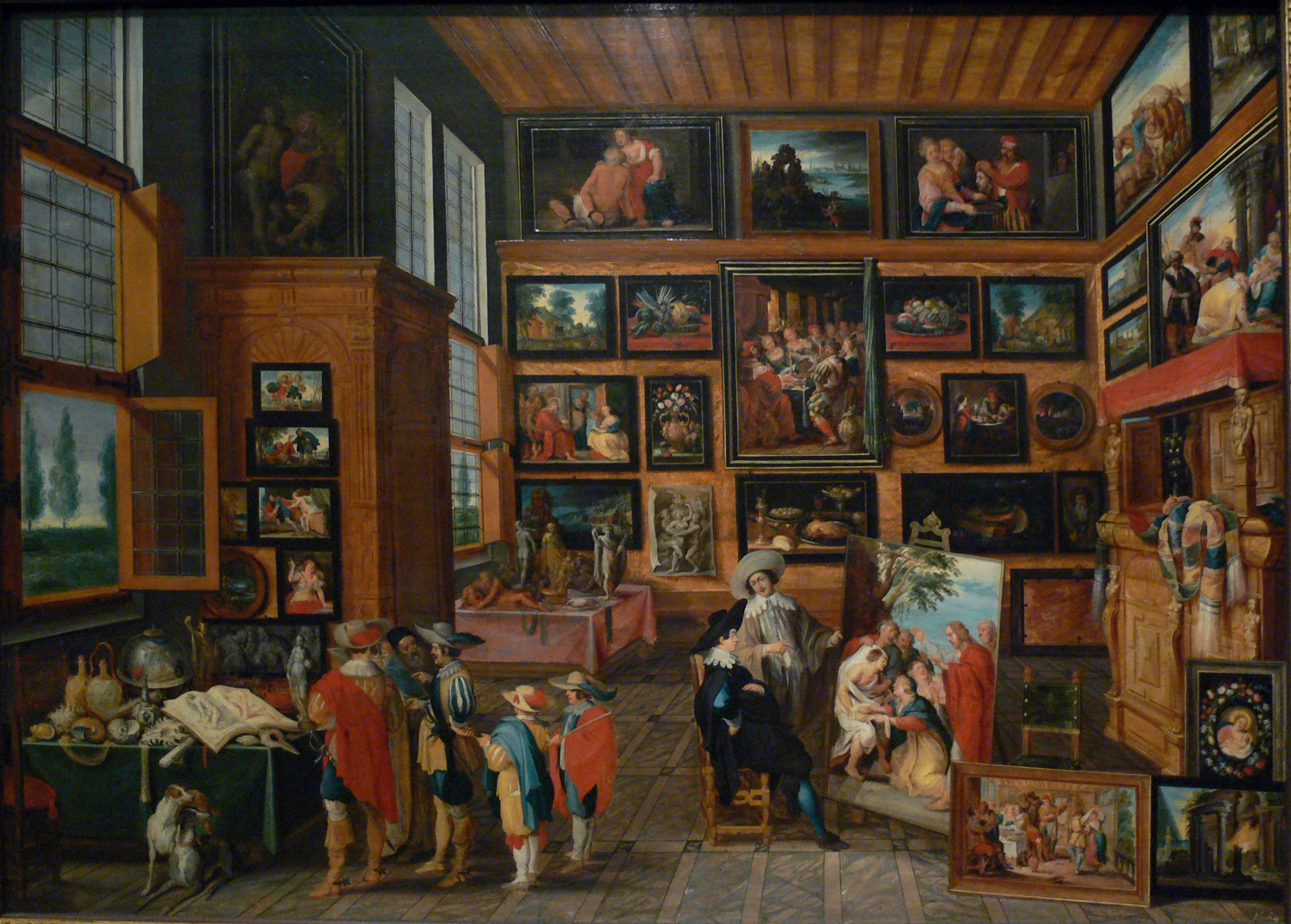|
Rockox House
The Snijders&Rockox House ( nl, Snijders&Rockoxhuis) is a museum in Antwerp, Belgium. It is located in two neighbouring townhouses formerly owned by the artist Frans Snyders (1579–1657) and the mayor Nicolaas Rockox (1560–1640). It is owned by KBC Bank and showcases a collection of 16th century art. History The house was rebuilt for Nicolaas II Rockox, lord Mayor of Antwerp. He had different houses united in 1603, and restored in Renaissance style. It was his principal residence which he used for business and it was built in baroque style. A few of Rubens' most famous artworks were specially designed for this residence, among them ''Samson and Delilah''. The Rockox family sold the estate in 1715 to benefit the poor: the house became property of the KBC Bank, in 1970 and it is used as a public museum. Architecture The house is a typical example of the architecture that was popular with the bourgeoisie of the early 17th century in Antwerp. It has an inner garden with f ... [...More Info...] [...Related Items...] OR: [Wikipedia] [Google] [Baidu] |
Anthony Van Dyck - Portrait Of Nicolaes Rockox, C1621 - Hermitage Museum
Anthony or Antony is a masculine given name, derived from the ''Antonia (gens), Antonii'', a ''gens'' (Roman naming conventions, Roman family name) to which Mark Antony (''Marcus Antonius'') belonged. According to Plutarch, the Antonii gens were Heracleidae, being descendants of Anton, a son of Heracles. Anthony is an English language, English name that is in use in many countries. It has been among the top 100 most popular male baby names in the United States since the late 19th century and has been among the top 100 male baby names between 1998 and 2018 in many countries including Canada, Australia, England, Ireland and Scotland. Equivalents include ''Antonio'' in Italian, Spanish, Portuguese and Maltese; ''Αντώνιος'' in Greek; ''António'' or ''Antônio'' in Portuguese; ''Antoni'' in Catalan, Polish, and Slovene; ''Anton (given name), Anton'' in Dutch, Galician, German, Icelandic, Romanian, Russian, and Scandinavian languages; ''Antoine'' in French; ''Antal (given name ... [...More Info...] [...Related Items...] OR: [Wikipedia] [Google] [Baidu] |
Cornelis Massijs
Cornelis MassijsAlternative spellings of family name: Massys, Matsijs, Matsys, Messijs, Messys, Metsijs, Metsys (1508, Antwerp – c. 1556, unknown), was a Flemish Renaissance painter, draughtsman and engraver, mainly known for his landscapes and, to a lesser extent, genre scenes and portraits. He is regarded as an important figure in the transition from the fantastic landscapes of Joachim Patinir to the 'pure landscapes' of later Netherlandish landscape painting. Life He was the son of leading Antwerp painter Quinten Matsys and the younger brother of Jan, who also became a prominent painter. Cornelis Massijs at the He trained under ... [...More Info...] [...Related Items...] OR: [Wikipedia] [Google] [Baidu] |
Rubens House
The Rubenshuis () is the former home and workshop of Peter Paul Rubens (1577–1640) in Antwerp. Purchased in 1610, Rubens had the Flemish townhouse renovated and extended on the basis of designs by Rubens himself. After the renovations, the house and its courtyard garden had the outlook of an Italian ''palazzo'', which reflected the artistic ideals of Rubens. The ensemble is now a museum dedicated mainly to the work of Rubens and his contemporaries. Rubens's house during his lifetime A year after marrying Isabella Brant in 1609, Rubens began construction of an Italian-style villa on the then-Vaartstraat (now the Wapper, 9–11), at the time located at the banks of the Herentalse Vaart canal. Rubens designed the building himself, based on studies of Italian Renaissance palace architecture that also formed the basis of his ''Palazzi di Genova''. The layout included his home, studio, a monumental portico and an interior courtyard. The courtyard opens into a Baroque garden that h ... [...More Info...] [...Related Items...] OR: [Wikipedia] [Google] [Baidu] |
Lambert Lombard
Lambert Lombard (c. 1505 – August 1566) was a Renaissance painter, architect and theorist for the Prince-Bishopric of Liège. During his career he worked for Jan Gossaert in Middelburg and trained Frans Floris. Biography Lombard was born in Liège, where in 1532 he became court painter and architect. A few paintings and many drawings have been preserved. In 1537, he was sent to Rome by Érard de La Marck, prince-bishop of Liège, to buy works of art, and he discovered the wonders of the Italian Renaissance. On his return he brought not only works of art, but also the new ideas concerning art and the position of the artist, to Liège. His pupils were Frans Floris, Hendrick Goltzius, Willem Key, Dominicus Lampsonius, , and .Lambert Lombard in the |
Paulus Pontius
Paulus Pontius (May 1603 in Antwerp – 16 January 1658 in Antwerp) was a Flemish engraver and painter. He was one of the leading engravers connected with the workshop of Peter Paul Rubens. After Rubens' death, Pontus worked with other leading Antwerp painters such as Anthony van Dyck and Jacob Jordaens.Max Rooses, ''Rubens'', Volume 1, 1904, London, Druckworth & Co., p. 333–334Paulus Pontius (I) at Life Paulus Pontius was born in Antwerp where he was apprenticed to the still life painter |
Lucas Faydherbe
Lucas Faydherbe (also spelled Lucas Faijdherbe; he signed as Lucas Fayd'herbe) (Mechelen, 19 January 1617 – Mechelen, 31 December 1697)De Inventaris van het Onroerend Erfgoed: Lucas Faydherbe was a Southern Netherlands, Flemish sculptor and architect who played a major role in the development of the High Baroque in the Southern Netherlands. Life Lucas Faydherbe was the first son of Hendrik Faydherbe and his second wife Cornelia Franchoys. His mother came from an artist family: her father was the successful painter Lucas Franchoys the Elder and her brothers Lucas Franchoys the Younger, Lucas and Peter Franchoys, Peter were also accomplished painters. His father's sister Maria Faydherbe was recognised as a talented sculptor. Faydherbe's father ran a workshop for d ...[...More Info...] [...Related Items...] OR: [Wikipedia] [Google] [Baidu] |
Joachim Patinir
Joachim Patinir, also called Patenier (c. 1480 – 5 October 1524), was a Flemish Renaissance painter of history and landscape subjects. He was Flemish, from the area of modern Wallonia, but worked in Antwerp, then the centre of the art market in the Low Countries. Patinir was a pioneer of landscape as an independent genre and he was the first Flemish painter to regard himself primarily as a landscape painter. He effectively invented the world landscape, a distinct style of panoramic northern Renaissance landscapes which is Patinir's important contribution to Western art.Hans Devisscher. "Patinir, Joachim." Grove Art Online. Oxford Art Online. Oxford University Press. Web. 30 April 2022. Subscription required His work marks an important stage in the development of the representation of per ... [...More Info...] [...Related Items...] OR: [Wikipedia] [Google] [Baidu] |
Quentin Matsys
Quentin Matsys ( nl, Quinten Matsijs) (1466–1530) was a Flemish painter in the Early Netherlandish tradition. He was born in Leuven. There is a tradition alleging that he was trained as an ironsmith before becoming a painter. Matsys was active in Antwerp for over 20 years, creating numerous works with religious roots and satirical tendencies. He is regarded as the founder of the Antwerp school of painting, which became the leading school of painting in Flanders in the 16th century. He introduced new techniques and motifs as well as moralising subjects without completely breaking with the tradition.Nanny Schrijvers, ''Quinten Massijs '' at Flemish Primitives Early life Most early accounts of Matsys' life are composed primarily of legend and very little con ...[...More Info...] [...Related Items...] OR: [Wikipedia] [Google] [Baidu] |
David Teniers The Younger
David Teniers the Younger or David Teniers II (bapt. 15 December 1610 – 25 April 1690) was a Flemish Baroque painter, printmaker, draughtsman, miniaturist painter, staffage painter, copyist and art curator. He was an extremely versatile artist known for his prolific output.Teniers the Younger, David at the National Gallery of Art He was an innovator in a wide range of genres such as history painting, genre painting, , |
Maerten De Vos
Maerten de Vos, Maerten de Vos the Elder or Marten de Vos (1532 – 4 December 1603)Maerten de Vos at the was a Flemish painter. He is known mainly for his and allegorical paintings and portraits. He was, together with the brothers Ambrosius Francken I and |
Jacob Jordaens
Jacob (Jacques) Jordaens (19 May 1593 – 18 October 1678) was a Flemish painter, draughtsman and tapestry designer known for his history paintings, genre scenes and portraits. After Peter Paul Rubens and Anthony van Dyck, he was the leading Flemish Baroque painter of his day. Unlike those contemporaries he never travelled abroad to study Italian painting, and his career is marked by an indifference to their intellectual and courtly aspirations.d'Hulst, pp. 23 In fact, except for a few short trips to locations elsewhere in the Low Countries, he remained in Antwerp his entire life. As well as being a successful painter, he was a prominent designer of tapestries.d'Hulst, pp. 24–25. Like Rubens, Jordaens painted altarpieces, mythological, and allegorical scenes, and after 1640—the year Rubens died—he was the most important painter in Antwerp for large-scale commissions and the status of his patrons increased in general.d'Hulst, p. 26–27. However, he is best known today for ... [...More Info...] [...Related Items...] OR: [Wikipedia] [Google] [Baidu] |
Hans III Jordaens
Hans III Jordaens (1590 – 1643), was a Flemish Baroque painter. Biography According to the RKD his birth year and place is uncertain. He could have been born in Delft as a son of Hans Jordaens, or he may have been born in Antwerp as a relative of Jacob Jordaens. He painted historical allegories, interiors, animals, and art galleries.Hans Jordaens in the He also painted staffage for . His works are often confused with works of other painters by the same name. According to Houbraken, the widow of the lawyer Nicolaas Muys van Holy (16 ... [...More Info...] [...Related Items...] OR: [Wikipedia] [Google] [Baidu] |





_-_Portrait_of_Joachim_Patinir.jpg)




